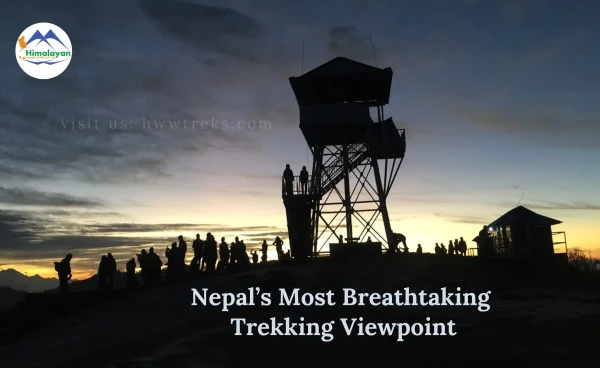- 04/25/2025
- Tags: Trekking permit
- Himalayan Wander Walkers
Nepal Trekking Permits and Cost
Trekking permits are mandatory in Nepal for all kinds of trekkers, whether he/she is traveling in a group or solo. Each permit fee is different from others depending on the specific trekking regions. So, make sure that you have your permits before embarking on your treks in the mountain regions of Nepal.
Nepal trekking permits are issued by different government bodies and associated authorized bodies such as the Department of Immigration office, Nepal Tourism Board, Trekking Agencies of Association of Nepal (TAAN), and National Trust for Nature Conservation (NTNC) to regulate and monitor all trekking destinations.
Is it mandatory to get a permit for trekking in Nepal?
Almost all mountain regions of Nepal require trekking permits. If the checkpoints find trekkers visiting without a permit, it may lead to big trouble by paying penalties for violation of tourism rules and regulations. So, it is better to have your permit before starting your trek.
Let us demystify the confusion about Nepal trekking permits by going through the details given below. Please read thoroughly all the different topics below.
Contents [hide]
- Different categories of trekking permits in Nepal
- 1. TIMs E-Card Permit
- 2. Restricted trekking permit (Special Permits)
- What are documents require for trekking company to obtain a Restricted Area Permit ?
- 3. National park permit
- 4. Conservation area permit
- 5. Rural municipality trekking permit
- Personal documents that are required to obtain Trekking Permits in Nepal
Different categories of trekking permits in Nepal
In general, there are four different trekking permits in Nepal. Each trekking region requires different trekking permits to visit. We explained all the permits, including their cost, and also stated which permits are needed for each trekking region.
1. TIMs E-Card Permit

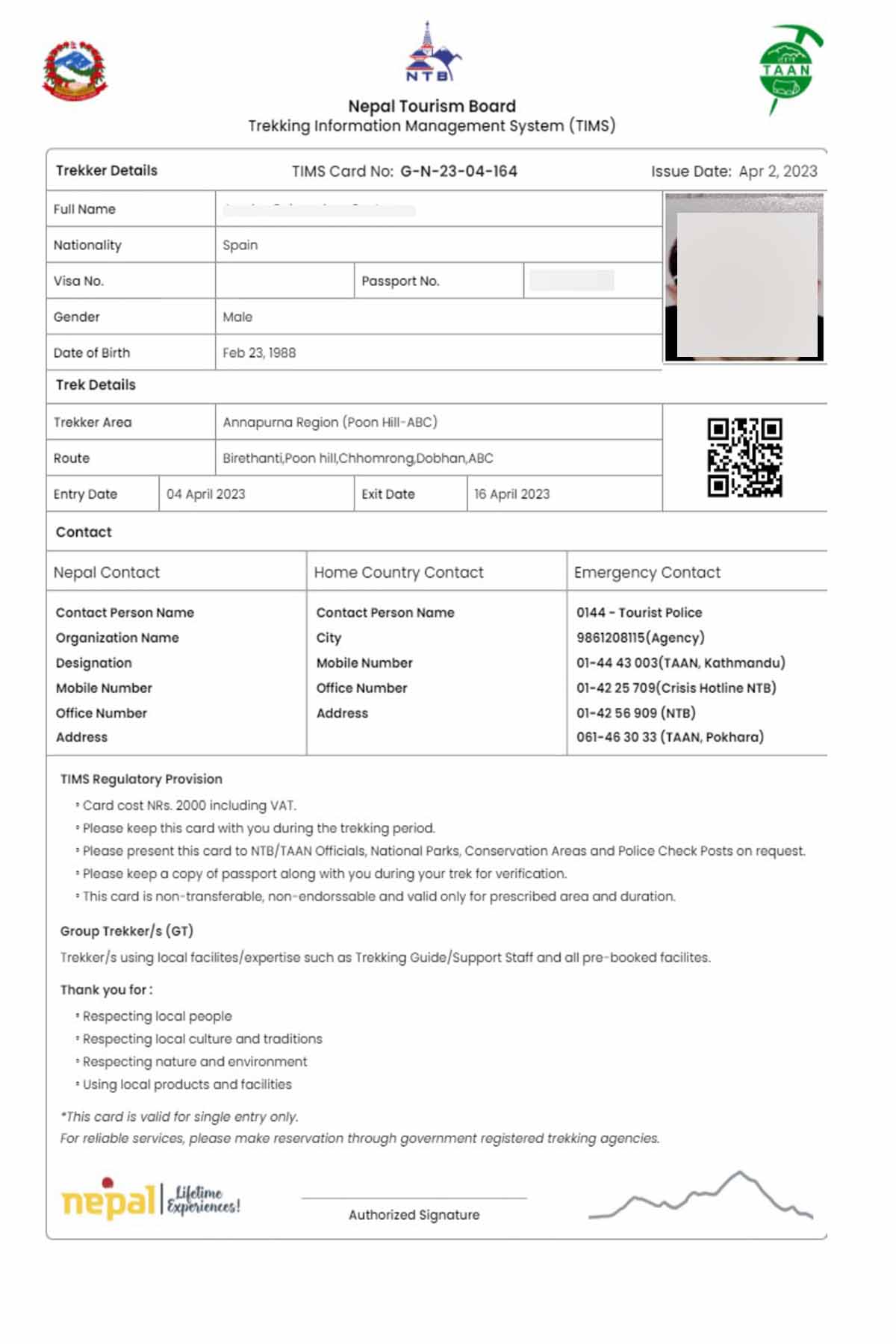
E-TIMS Card is the short form of Trekkers' Information Management System, which has been implemented jointly by the Nepal Tourism Board (NTB) and Trekking Agencies Association of Nepal (TAAN) to ensure the safety and security of trekkers and to control illegal trekking operations in Nepal. Since the first January of 2008, TIMS card permit issuing to trekkers has been effectively implemented.
The E-TIMs card is the latest trekking permit, which came into effect on 1st April 2023, where the E-TIMs permit is not available for Free Individual Trekkers (FITs) but for group trekkers taking the service of government-authorized trekking agencies.
In the past, TIMS permits were issued by the Nepal Tourist Board to free individual trekkers directly by filling up the form available in the tourism office at Brikutimandap. Since the 1st of April, an E-TIMS card has been mandatory for all trekking areas of Nepal except restricted areas where trekkers receive special permits from the Department of Immigration Office.
TIMS cards cost NPR 2000 per person for international trekkers and NPR 1000 for SAARC (South Asian Association for Regional Cooperation).
If any of the trekkers found traveling on designated trekking trails without a guide or TIMS card faces a Rs12,000 fine.
2. Restricted trekking permit (Special Permits)
A restricted trekking permit is also often known as a special permit. Even though trekkers in Nepal are allowed to trek as FITs (Free Individual Trekkers) or in groups of various sizes. However, there are certain trekking regions known as 'Restricted Areas' or ‘Controlled Areas’ that are highly regulated by the Government of Nepal, and hence FITs are strictly forbidden.
A restricted trekking permit is issued from the Department of Nepal Immigration only through a registered trekking office like Himalayan Wander Walkers (HWW). Please find the restricted area permit (RAP) fees in the below table.
Restricted Areas and Permit Fees for trekking in Nepal
| S.No. | Restricted Trekking Areas | Permit Fee |
| 01 | Upper Mustang |
USD500 per person (for the first 10 days) USD 50 per person/Day (beyond 10 days) |
| 02 | Upper Dolpa |
USD500 per person (for the first 10 days) USD 50 per person/Day (beyond 10 days) |
| 03 | Gorkha Manaslu Area |
September – November USD 100 per person/week USD 15 per person/day (beyond 1 week) December – August USD 75 per person/week USD 10 per person/day (beyond 1 week) |
| 04 | Humla |
USD 50 per person/week USD 10 per person/day (beyond 1 week) |
| 05 | Taplejung (Olangchung Gola and Kanchenjunga) |
USD 20 per person/week (for the first 4 weeks) USD 25 per person/week (beyond 4 weeks) |
| 06 | Lower Dolpa Area |
USD 20 per person/week USD 5 per person day (beyond 1 week) |
| 07 | Dolakha (Lapche Valley and Tashi Lapcha Pass) | USD 20 per person/week |
| 08 | Gorkha Tsum Valley Area |
September – November USD 40 per person/week USD 7 per person/day (beyond 1 week) December – August USD 30 per person/week USD 7 per person/day (beyond 1 week) |
| 10 | Sankhuwasabha (Makalu Area) |
USD 20 per person/week (for the first 4 weeks) USD 25 per person/week (beyond 4 weeks) |
| 11 | Solukhumbu (Thame and Tashi Lapcha Area) |
USD 20 per person/week (for the first 4 weeks) USD 25 per person week (beyond 4 weeks) |
| 12 | Rasuwa (Rasuwaghat and Thuman Area) | USD 20 per person/week |
| 13 | Manang (Nar and Phu Valley) |
September – November USD 100 per person/week USD 15 per person/day (beyond 1 week) December – August USD 75 per person/week USD 15 per person/day (beyond 1 week) |
| 14 | Bajhang (Mount Saipal Area) |
USD 90 per person/week for the first week USD 15 per person/day (beyond 1 week) |
| 15 | Mugu (Mugum Karmarong Rural Municipality) |
USD 100 per person/week USD 15 per person/day (beyond 1 week) |
| 16 | Darchula (Api and Nampa Himal Area) |
USD 90 per person/week USD 15 per person/day (beyond 1 week) |
What are documents require for trekking company to obtain a Restricted Area Permit ?
Only authorized trekking agencies can apply for restricted area trekking permits along with the following documents from the department of the immigration office.
- Copy of Passport
- Copy of valid Visa sufficient to cover trekking days
- Name lists of trekkers
- Program Schedule of trekking
- Guarantee letter of Agency
- Agreement with Agency
- Tax clearance Certificate of Trekking Agency
- Documents relating to insurance of the trekkers (foreign nationals) and Nepalese staff accompanying the trekkers
- License issued by The Ministry of Tourism, Culture and Civil Aviation to operate trekking business
- License issued by Nepal Rastra Bank allowing exchange of foreign currencies
- The program schedule for trekking (Day wise itinerary)
- Registration Certificate of Permanent Account Number
- Voucher of Bank payment (fees) for permits
3. National park permit
A national park permit is another permit that is required for trekking in Nepal. There are 12 national parks, one hunting reserve, and one wildlife reserve. All these are monitored by the Department of National Parks and Wildlife Conservation (DNPWC). DNPWC was established in 2037 BS (1980 AD) to manage and conserve the wildlife and biodiversity of Nepal. These protected areas cover the ecosystems and landscapes of the high mountain region, hilly region, and plain region of the country.
National park permits are issued at Bhrikuti Mandap by the Department of National Parks and Wildlife Conservation (DNPWC) located within the Nepal Tourism Board building.
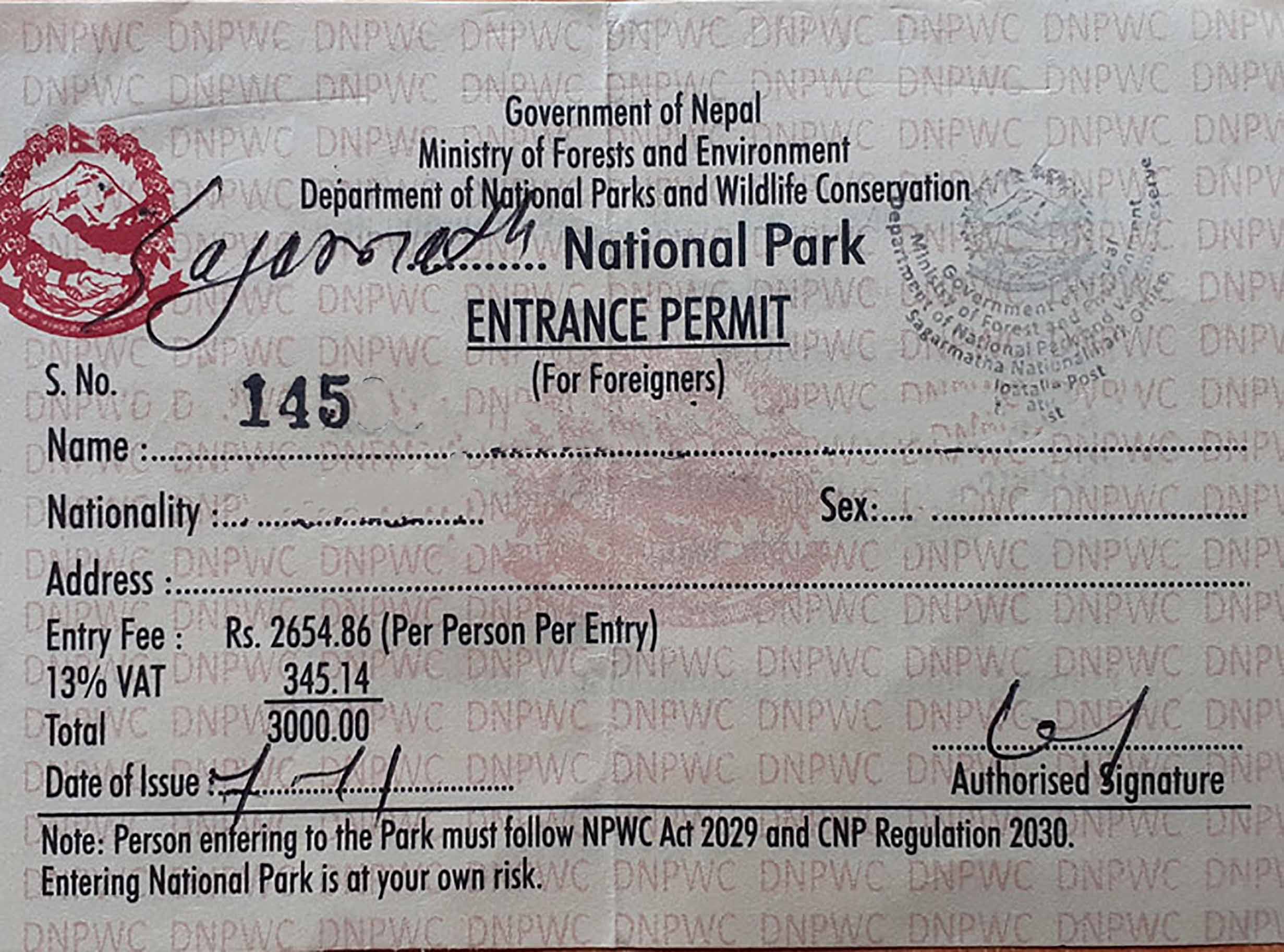
National Parks and Permit Fees for Trekking in Nepal
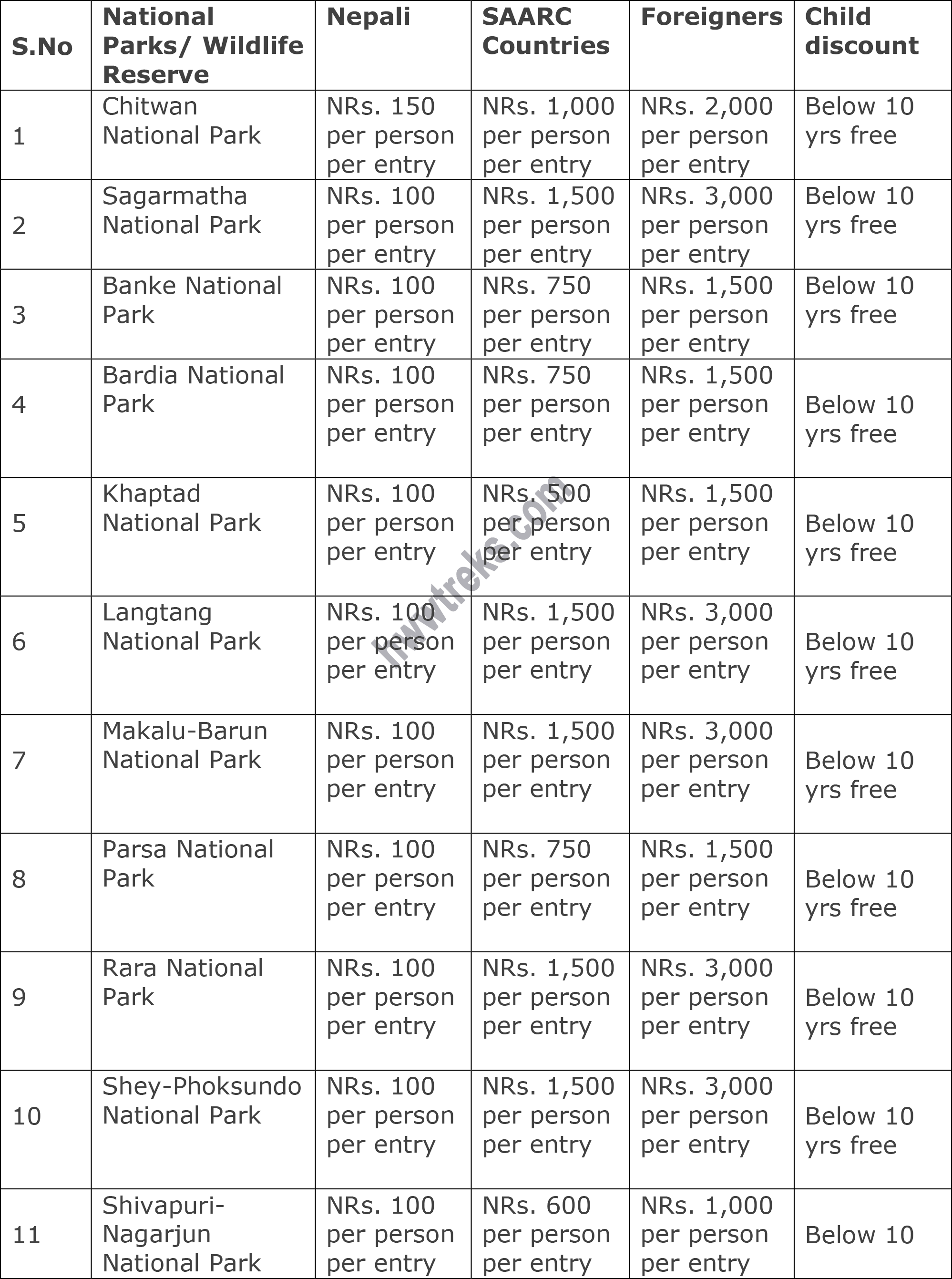
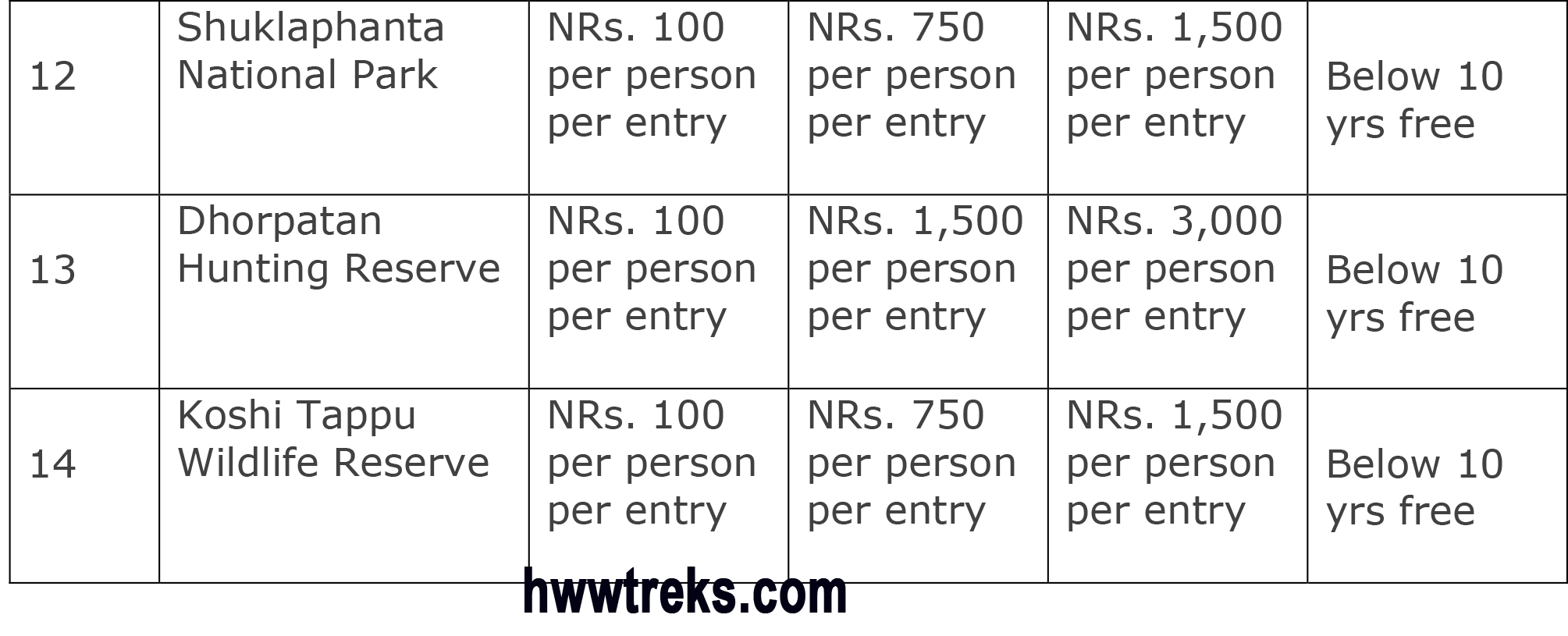
4. Conservation area permit
A conservation permit is similar to a national park permit, which is issued and managed by the National Trust for Nature Conservation (NTNC). NTNC was established in 1982 AD under a legislative act to work in the field of nature conservation in Nepal and is a not-for-profit organization. There are 6 conservation areas in Nepal, which are listed below with their respective fees for trekking. All the visitors who are entering these conservation areas are required to purchase a conservation permit before starting their treks or tours.
Conservation permits are issued at Bhrikuti Mandap by the National Trust for Nature Conservation (NTNC) permit counter located within the Nepal Tourism Board building.
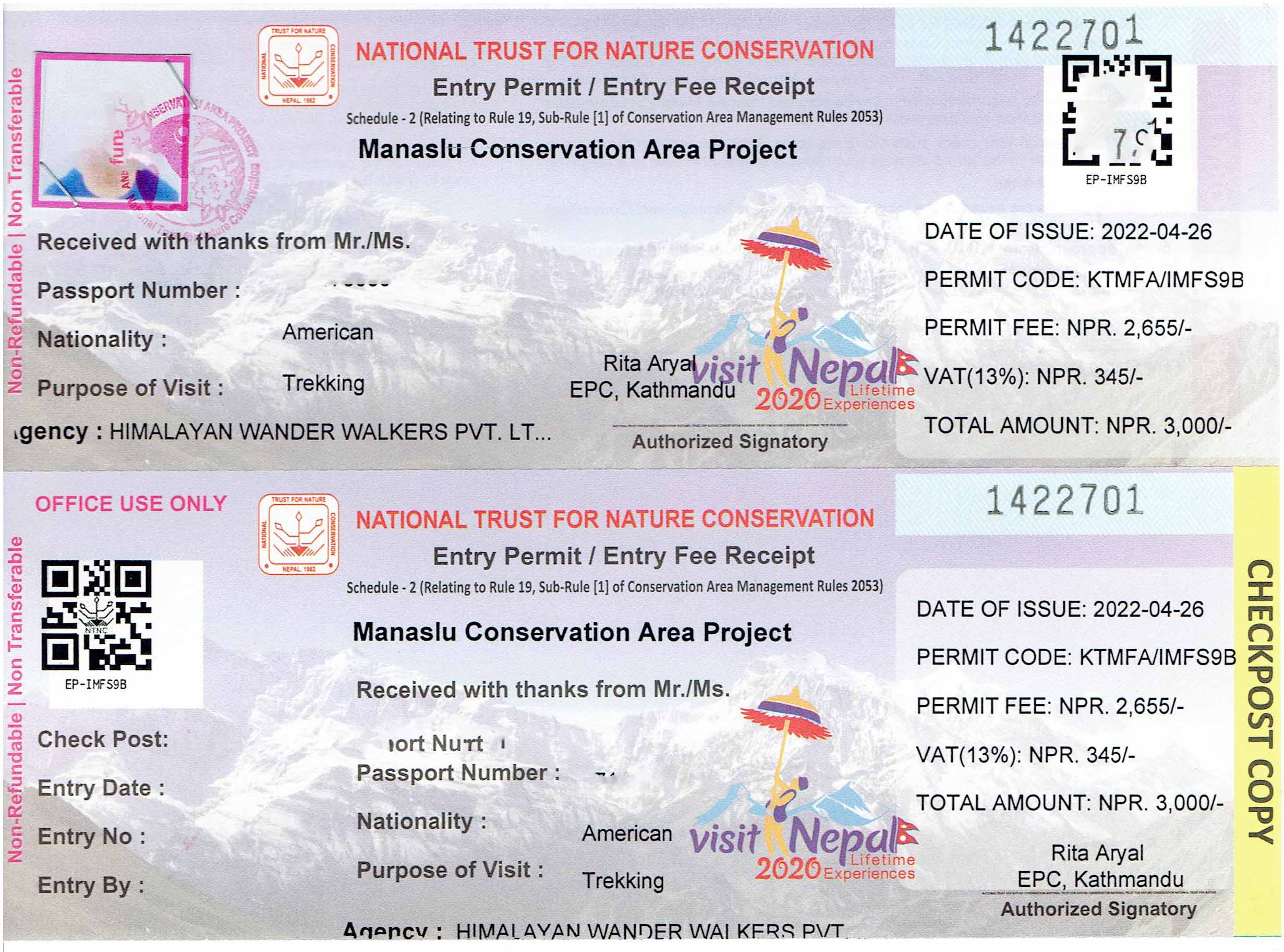
Conservation Area and Permit Fee for Trekking in Nepal
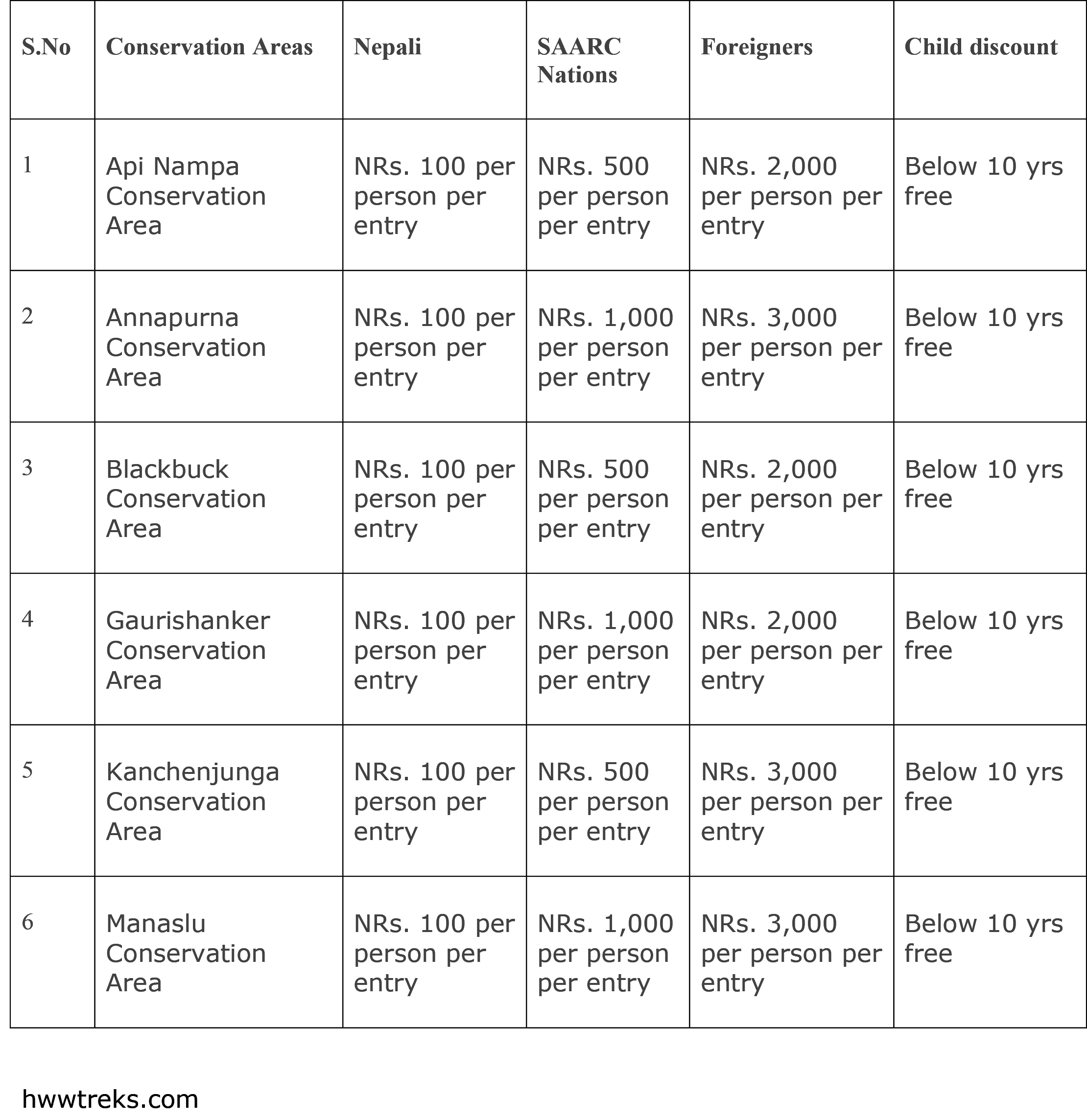
5. Rural municipality trekking permit
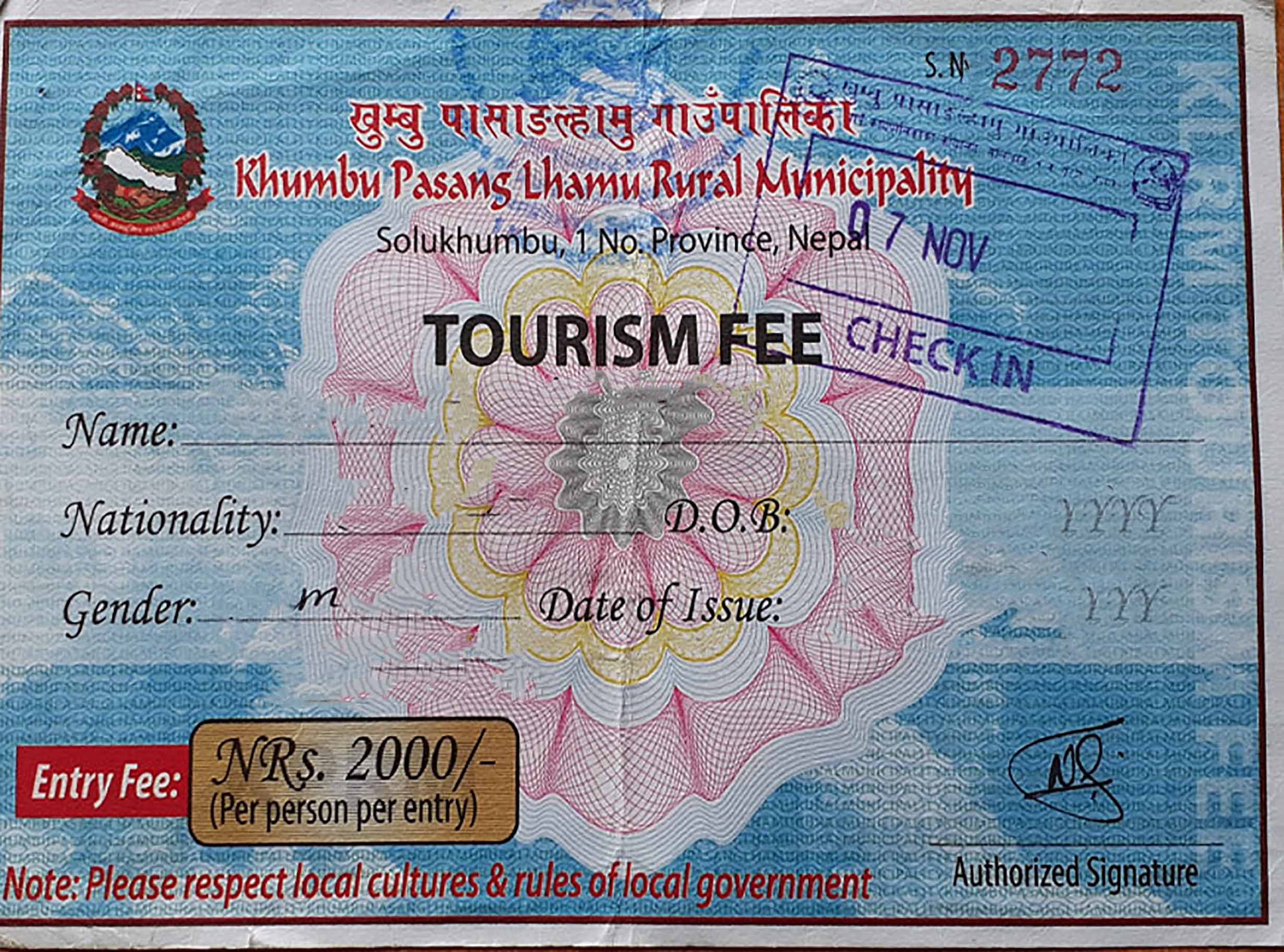
Rural Municipality (RM) administrative division was established in 2017 and replaced the existing village development committees. There are currently 460 rural municipalities. Since 2018 Khumbu Pasang Lhamu Rural Municipality is the only local level government among all the rural municipalities that implemented the trekking permit rule for trekkers in the Khumbu region. Before TIMS Card permit was used and carried by all trekkers in the Everest region.
Khumbu Pasang Lhamu Rural Municipality used to cost NPR 2000 for every individual until September 2024, when it increased to NRP 3000.
Personal documents that are required to obtain Trekking Permits in Nepal
When booking a trek or tour with us (Himalayan Wander walkers), we kindly request you to provide the following documents:
- Passport or Travel Documents
- A valid passport copy
- A recent passport size photo
- Your contact details
- Complete documents of travel and health insurance
- Your Arrival Details and Departure flight Details
